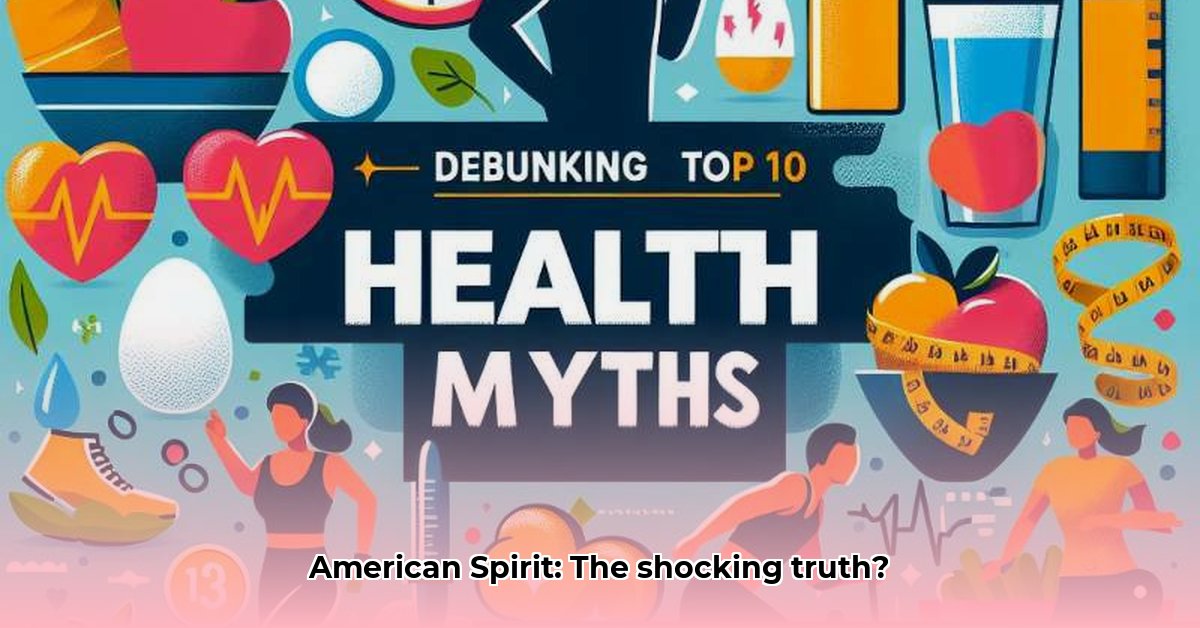American Spirit cigarettes. Sounds healthy, right? Pictures of nature, maybe a feeling of being a bit more…natural. But that image? It’s mostly smoke and mirrors. This article cuts through the marketing fluff and shows you the real deal about American Spirit – the hidden dangers, the addictive power, and the ways the company uses clever tricks to sell a product that’s seriously bad for you. We’ll dig into the science, compare them to other cigarettes, and show you why the whole “natural” thing is a big lie. We’ll even look at how they use marketing and pricing to make people think they’re getting something better. For more in-depth information, check out this comprehensive study. Most importantly, we’ll give you the tools and resources you need if you’re ready to kick the habit for good. Get ready to see American Spirit in a whole new light.
Debunking American Spirit Health Myths and Misconceptions
Have you ever seen those sleek, earthy-toned American Spirit cigarette packs? They whisper promises of something “natural,” something somehow better than other cigarettes. But is that really the truth? Let’s dig into the surprising reality behind the marketing hype and expose the shocking truths about American Spirit cigarettes.
The “All-Natural” Charade: A Clever Marketing Trick and Health Halo
American Spirit’s marketing emphasizes the word “natural.” Pictures of rolling hills and sun-drenched fields create the illusion of a wholesome product. This clever strategy plays on our ingrained bias towards anything presented as “natural”—we assume it’s healthier. But is this true when it comes to cigarettes? Absolutely not.
While American Spirit claims to use tobacco grown without certain additives, the critical fact remains: they’re still cigarettes. Burning tobacco, regardless of how it was grown, releases a cocktail of over 7,000 chemicals. Many of these are known carcinogens—substances that cause cancer. So, while they might avoid some artificial ingredients, the fundamental act of burning tobacco remains incredibly hazardous to your health. The “natural” claim is, at best, misleading and, at worst, a cynical ploy to make a dangerous product seem less harmful. Consider this: does the avoidance of some additives truly negate the presence of thousands of other harmful compounds produced during combustion, including tar, benzene, and formaldehyde?
Nicotine’s Addictive Grip: Why Quitting Is So Hard
Let’s be clear: Nicotine is powerfully addictive. American Spirit cigarettes, despite their marketing, deliver a hefty dose of nicotine. This addictive nature is the reason so many smokers struggle to quit, even when they fully understand the health risks. It’s not a matter of simply lacking willpower; it’s a biological dependence. The longer you smoke, the stronger the grip of nicotine becomes. Breaking free requires significant effort and often professional support.
Nicotine works by stimulating the release of dopamine, a neurotransmitter in the brain associated with pleasure and reward. This creates a temporary sense of euphoria, reinforcing the behavior of smoking. Over time, the brain adapts to the presence of nicotine, requiring higher doses to achieve the same effect – a phenomenon known as tolerance. When nicotine levels drop, withdrawal symptoms such as irritability, anxiety, and intense cravings can occur, making quitting incredibly challenging. The addiction potential of nicotine is comparable to that of heroin or cocaine.
This addiction isn’t merely an inconvenience; it’s a serious obstacle to a healthier life.
The Price of “Premium”: A False Sense of Security and Financial Burden
American Spirit cigarettes often command a higher price than many other brands. This higher price point subtly reinforces the notion that they’re somehow superior, more refined, and—dare we say it—healthier. This is pure marketing magic. The increased cost doesn’t translate to reduced health risks. It’s simply a tactic to create a perception of higher quality, justifying the price and furthering the illusion that these are somehow “less bad” than other cigarettes. It’s a very clever, yet ultimately deceitful, strategy. Beyond the health implications, the financial burden of smoking American Spirit cigarettes can be substantial, potentially costing thousands of dollars per year.
Health Consequences: The Grim Reality of Smoking
The health consequences of smoking American Spirit cigarettes are identical to those of any other brand. The risks are substantial and well-documented. We’re talking about a significantly increased risk of lung cancer, heart disease, chronic obstructive pulmonary disease (COPD), emphysema, stroke, and a host of other debilitating illnesses. These aren’t theoretical risks; these are real-world consequences affecting countless lives every year. The “natural” marketing is simply a distraction from the grave dangers.
Some studies have investigated the levels of specific chemical compounds in American Spirit cigarettes compared to other brands. While some studies suggest variations in the concentrations of certain toxins, it’s crucial to understand that even small differences do not negate the overall harm. Moreover, some studies suggest that American Spirit cigarettes may contain higher levels of free-base nicotine, making them potentially more addictive than other brands.
Regulatory Scrutiny: A Necessary Step for Consumer Protection
The FDA has taken some action against American Spirit’s misleading marketing, challenging their claims of superiority and increased “naturalness.” In 2015, the FDA issued a warning letter to Santa Fe Natural Tobacco Company (SFNTC) for using the terms “additive-free” and “natural” in their marketing, suggesting that these cigarettes might be less harmful than other cigarettes. However, more needs to be done. Stronger regulations are crucial to ensure transparency and protect the public from deceptive marketing tactics. The current regulatory landscape needs strengthening to prevent misleading marketing and address the potential harms associated with the term “organic” and the co-opting of American Indian imagery.
Taking Control: Your Journey to a Healthier Life & Resources for Quitting
Quitting smoking is undeniably challenging, but it’s absolutely achievable. The benefits far outweigh the struggle. Many resources are available to support you on your journey. These include:
- Professional help: Your doctor or a therapist can provide personalized advice and support.
- Cessation programs: Numerous programs offer counseling, medication, and community support. The National Cancer Institute offers a comprehensive guide to quitting smoking at cancer.gov.
- Nicotine replacement therapy: Patches, gum, lozenges, and inhalers can help manage withdrawal symptoms. These are available over-the-counter and can significantly increase your chances of success.
- Prescription medications: Medications like bupropion and varenicline can help reduce cravings and withdrawal symptoms. Talk to your doctor to see if these are right for you.
- Support groups: Connecting with others facing similar challenges can make a significant difference. Organizations like the American Lung Association offer online and in-person support groups.
Remember, there are no “safe” cigarettes. Nicotine addiction is treatable, and recovery is possible.
The Bottom Line: Truth Over Hype
The “natural” image of American Spirit cigarettes is a sophisticated piece of marketing, a carefully constructed illusion that obscures the harsh reality of smoking. Ultimately, this “natural” approach is simply a tactic to sell a dangerous product. It’s time to see through the carefully crafted image and make informed choices about your health.
How do American Spirit cigarettes’ “natural” claims compare to their actual health risks and long-term effects?
Key Takeaways:
- American Spirit’s “natural” marketing is misleading. These cigarettes still contain nicotine and harmful chemicals.
- “Natural” does not equal “safe” when it comes to smoking. Combustion creates carcinogens regardless of tobacco type.
- While some studies show slightly lower levels of certain toxins in some American Spirit varieties, the overall health risks remain significant.
- The higher nicotine content in some American Spirit varieties and potential for increased puffs per cigarette significantly elevates the risks.
- American Spirit’s marketing, including its use of Native American imagery, exploits cultural perceptions to create a false sense of reduced harm.
- Quitting smoking, regardless of brand, is crucial for better health.
The “Natural” Illusion: Unpacking American Spirit’s Marketing
American Spirit cigarettes boast “natural” tobacco. But what does that truly mean for your health? Let’s examine this claim. Burning any tobacco generates harmful chemicals, regardless of how it’s grown or labeled. The “natural” label doesn’t remove the fundamental danger of combustion. The absence of some additives does little to change the outcome of inhalation.
Organic tobacco, while grown without synthetic pesticides and herbicides, still contains nicotine and produces harmful chemicals when burned. This means that smoking organic tobacco carries the same health risks as smoking conventional tobacco.
What about nicotine? That highly addictive substance remains a potent danger. American Spirit contains it, meaning addiction and its associated health problems are extremely likely. Higher nicotine levels in some varieties exacerbate this risk.
Nicotine’s Grip: Addiction and its Consequences, Understanding the Brain’s Reward System
Nicotine is a highly addictive drug. It hijacks the brain’s reward system, leading to dependence. Nicotine stimulates the release of dopamine, a neurotransmitter associated with pleasure and reward. Over time, the brain adapts to the presence of nicotine, requiring higher doses to achieve the same effect. This leads to tolerance and dependence, making quitting incredibly difficult. All cigarettes pose a serious risk of lung cancer, cardiovascular diseases, and chronic respiratory illnesses.
The Marketing Maneuver: Ethically Questionable Tactics
American Spirit utilizes powerful imagery and misleading language, associating itself with nature and Native American culture—an ethically questionable tactic. This deceptive marketing creates a false sense of security, undermining public health efforts. The higher price point
- Lunch Box That Fits Bento Box Neatly for Daily Use - December 5, 2025
- Japanese Lunch Bag Does Double Duty as Bento Carrier and Tote - December 4, 2025
- Your Perfect Bento Box Bag For Fresh And Tidy Meals - December 2, 2025










